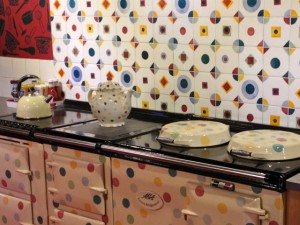There’s a new and very distinguished international cultural itinerary through five countries, on the trail of an item that has seduced us for centuries.
The ultimate thrill would be to spend a week, or more reasonably two, following the invisible thread running from Limoges in France, down to Faenza, Italy; then up to Germany for Höhr-Grenzhausen and Selb. Cross into the Netherlands and visit Delft, then hop the North Sea to the city which has, according to its website, “respectfully claimed the title of World Capital of Ceramics” – Stoke-on-Trent.
While you wait for your tickets to join the European Route of Ceramics to come through (or your savings to mount) you could simply follow the gorgeous taster images on ViaCeram’s Twitter feed.
Feast on the exuberant wall of red and yellow pots outside the Musée National de la Porcelaine Adrien-Dubouché in Limoges, for example. Or the alleyway in Selb, paved with a mosaic of 55,000 porcelain tiles in a palette of many colours. Enjoy the warm, sumptuous, orangey-red hues on a pot on display in Höhr-Grenzhausen. And the deeply elegant blues of Delft, set into city benches and pavements.
Then there is Stoke-on-Trent. This foundation stone of industrial-scale pottery offers a huge range, contemporary and classical. From the sunniest ceramics around in Emma Bridgewater’s factory, a place of pink hearts and colourful polka dots, and the exuberant splatter pattern in cobalt blue; to Moorcroft where pottery became fine art.
It is simple, and admirable, ambition. A collection of European cities with fine ceramic traditions have come together to promote their shared creative tradition and tourist appeal.
This is an important European initiative. Three quarters of the 280,000 euros to fund ViaCeram comes from the European Commission. The participating cities put up the rest, to “co-promote a shared history, heritage and visitor experience”.
In 2012, the European Route of Ceramics was designated a “Cultural Route” by the Council of Europe, giving it the status of “destination of excellence” for tour operators and the general public.
I see great merit in linking the ceramic cities together like this – and why shouldn’t there be suggested diversions in the future, to smaller places with a similar artistic tradition?
The website suggests all sorts of variations, and add-ons (“urban or nature, romantic or family-friendly, gourmet”), to the standard museum visit. Although “standard” is hardly the word. The International Museum of Ceramics in Faenza is described as the worlds largest collections, and “one of the greatest ceramics museums in the world,”
Look around workshops. Make, and colour pots for yourself. See the wider city; take a trip into the surrounding countryside; take “romantic, gastronomic and other non-ceramic detours”.
While it is not a claim they all can make, there are beautiful historic centres, cathedrals and Renaissance churches to explore. In Delft, with canals, historic houses and picturesque bridges, it’s the urban landscape of native son Vermeer and other great 17th-century Dutch painters. Limoges offers “the entire Middle Ages in a nutshell”.
The site promotes fine dining opportunities in Faenza and Limoges. Delft is recommended for its “green getaway” (after you visit the last remaining factory from the 17th century, where Delftware is still hand-painted) on foot or by bike, along the canals. There are ceramic trails and public transport links around Selb and Höhr-Grenzhausen.
Stoke-on-Trent has well over a day’s worth of operating ceramics businesses to visit, with the “World of Wedgwood” visitor centre to come in 2015. Wedgwood has been welcoming visitors to its premises for 250 years.
The ceramic cities are already staging joint ventures – this month (November 2014) the Domesday Morris group Danced in the in the courtyard that Gladstone Pottery Museum, with an Italian folk dance group from the Faenza region and their accompanying guitarist and violinist.

